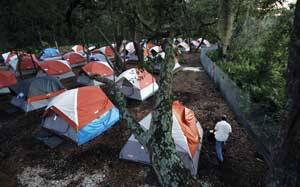Have persistent unemployment and waves of foreclosures led to a resurgence of the nation’s once widespread scourge of homelessness? The problem appears to be making a comeback, but not in the urban and rural communities where homelessness persisted in past decades. This time homelessness is becoming a prominent problem in the nation’s suburban communities.
The last formal count of the nation’s homeless, a 2009 report from the Department of Housing and Urban Development, tracked the problem to the end of September 2008. It found that while the overall number of homeless people remained steady at 1.6 million people, the number of homeless in suburbs and rural communities had spiked dramatically to 32 percent from 23 percent. It also reported that the number of homeless families in shelters grew from about 473,000 to 517,000.
Those figures complement the findings of a 2010 Brookings Institution report on poverty trends. That report, while arguing that federal anti-poverty responses remain mired in older models of rural- and urban-focused poverty, revealed that the nation’s largest and fastest-growing low-income populations are in the suburbs. Suburban poverty in large metropolitan areas grew 25 percent between 2000 and 2008. Midwestern cities and suburbs experienced the largest poverty rate increase during that period.
The U.S. Census Bureau will try to get a clearer national perspective on homelessness with its “Make the Homeless Count,” program, which will run from March 29 to 31. Some communities are aiding the campaign by encouraging their homeless residents to step out from the shadows. The Los Angeles Mayor’s Office of the Census has been asking residents to donate socks at L.A. police stations, city hall and other locations. The socks, along with food, will be distributed to the homeless at six events across the city on March 30 to encourage their participation in the national count.
Norma Vega, the executive director of the L.A. mayor’s census office, told Southern California Public Radio: “It’s our sort of small way of getting hopefully more awareness about this issue. And the socks are a way to remind us on an everyday basis that we do have a population out there that needs help.”
The effect of another year of rising joblessness and foreclosures at rates not seen since the Great Depression has not yet been depicted statistically, but social welfare agencies around the country offer anecdotal evidence of growing need and increasing family homelessness as the nation continues to confront a “perfect storm of foreclosures, unemployment and a shortage of affordable housing,” as one social service director told the Associated Press recently.
Catholic Charities USA’s Fourth Quarter Snapshot Survey, released on Jan. 28, revealed a dramatic increase nationwide in requests for life-sustaining emergency services. Of the 47 agencies responding to the survey, 83 percent reported an increase in the number of working poor seeking assistance; 70 percent reported an increase in families seeking assistance; 57 percent reported an increase in support requests from homeless people seeking assistance; and 51 percent reported an increase in requests from the middle class. Catholic Charities offered some perspective on the statistics: “These are unemployed parents; two-income families struggling to make ends meet; pregnant women and teens, homeless with nowhere to turn; former donors to Catholic Charities organizations now in need of help; and repeat clients with deeper needs and greater barriers to self-sufficiency.... The survey shows new and underserved populations continuing to request help. In sobering numbers, brutal temperatures coupled with rising utility rates and loss of income have left individuals and families hungry, homeless, and cold—many for the first time.”
p { margin-bottom: 0.08in; }
Read this article in Spanish. Translation courtesy Mirada Global.








